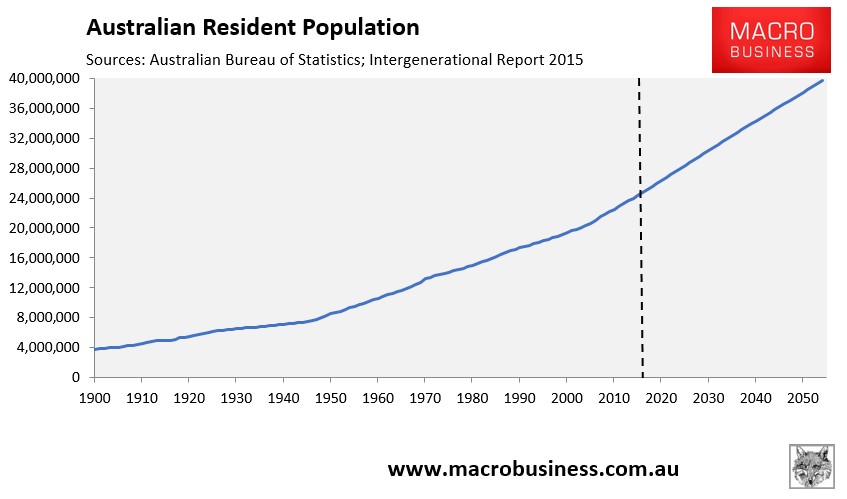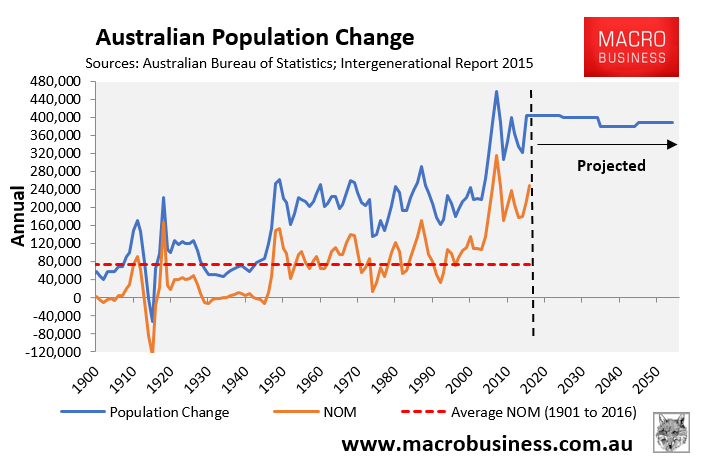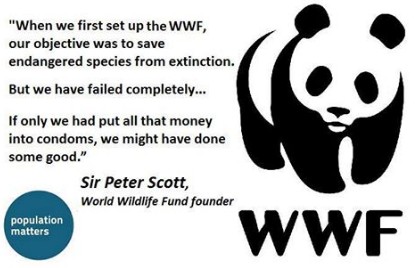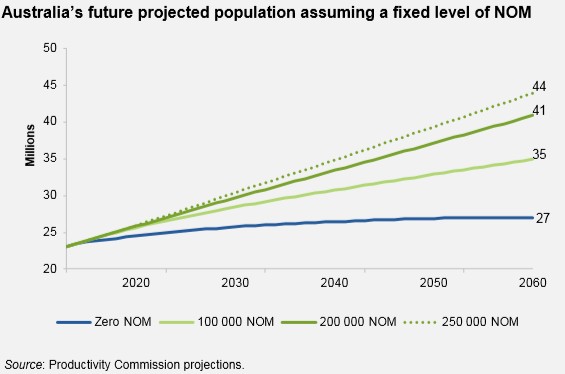Australia’s population growth has for more than a decade lead the world and is on track to nearly double the nation’s population mid-century to around 40 million people:

And this will be driven by annual population growth that is roughly twice as high as the post-war average, primarily due to mass immigration:

The latest federal government State of the Environment report, released last year, explicitly noted that Australia’s natural environment is being placed under acute strain from rapid population growth and economic development, and noted that these are the main drivers of environmental problems such as land-use change, habitat destruction, invasive species, and climate change.
Today, a team of scientists will publish their recommendations for slowing current rates of biodiversity loss in a paper in Nature Ecology and Evolution, which will include limiting human population growth. From The ABC:
Although key threats to biodiversity include habitat clearing for cattle, mining, and urban sprawl, these are all consequences of population pressure and high rates of resource consumption, according to Deakin University researcher Euan Ritchie.
“It’s often a taboo topic to talk about human population size and family planning and how much we consume as individuals,” Dr Ritchie said.
“But if we don’t address these issues in the context of biodiversity conservation and sustainability then we’re largely kidding ourselves”…
Dr Ritchie argues that Australia’s poor record on species loss means we need to be making changes to halt the demise of biodiversity here.
“We have the worst record in the world on mammal conservation, with 30 species likely to have become extinct since European settlement,” he said…
These aren’t the first environmental studies to draw the direct link between population growth and environmental degradation.
In 2010, Flinders University released a report to the Department of Immigration and Citizenship (DIAC) examining the “Long-Term Physical Implications of Net Overseas Migration” (NOM). This report concluded that “higher levels of NOM impose greater adverse impacts on the quality of our natural and built environments” and that the “geographical concentration… within Sydney, Melbourne and Perth… substantially increases their environmental impact”. The report also found that “decreased urban water supply is a significant environmental constraint exacerbated by higher levels of NOM”. In particular, “modelling shows the vulnerability of Sydney, Melbourne, Brisbane and Perth to deficits in water supply“.
The Flinders University report also noted that Australia’s water resources could only cope with NOM of up to 50,000 people a year (versus 210,000 currently):
Only NOM levels of 50,000 pa or less result in Melbourne and Sydney maintaining a small surplus of net surface supply over demand on average out to 2050, assuming current climate conditions persist. Potential options to alleviate water stress at high NOM levels over the longer term may be hard to find.
Also in 2010, the Australian Conservation Foundation (ACF) called for Australia’s population to be stabilised and nominated human population growth as a “key threatening process” to Australia’s biodiversity.
Meanwhile, well-known environmentalist and former Australian of the Year recipient, Professor Tim Flannery, has estimated that the long-term human carrying capacity of the Australian continent and Tasmania might be as low as 8 million to 12 million people and has many times called for the nation’s population to be stabilised.
In 1994, when Australia’s population was just under 18 million, the Australian Academy of Science (AAS) convened a symposium on the future population of Australia. Its analysis was extended to Australia’s resources of water, minerals and arable land, and the interactions between present lifestyle and present environmental damage, and between future expectations and the costs of increasing population.
The AAS cautioned that “if our population reaches the high end of the feasible range (37 million), the quality of life of all Australians will be lowered by the degradation of water, soil, energy and biological resources” and concluded that “the quality of all aspects of our children’s lives will be maximised if the population of Australia by the mid-21st Century is kept to the low, stable end of the achievable range, i.e. to approximately 23 million”. Just 24 years later, Australia is about to reach 25 million people, thus exceeding the AAS’ recommended maximum population.
International organisations and commentators, too, have raised alarm at population growth’s impacts on the environment.
Late last year, 15,364 scientists from 180 countries – “the largest group of scientists to have ever put their names to a research paper focused on climate change” – also put their names to a BioScience journal article calling for population growth to be limited, and governments to stop only focusing on economic growth.
The World Wildlife Fund (WWF) has nominated human population growth as the key risk factor for endangered species, noting that “the current rate of extinctions is 100 times what would be considered normal without the impact of human activity… more of us means more of that” (see below graphic).

Whereas legendary documentary maker, David Attenborough, has nominated human population growth as the most fundamental issue facing the world.
The fact of the matter is that there are few better policy solutions to protect Australia’s environment than limiting population growth and abandoning plans for a ‘Big Australia’, which necessarily means significantly cutting immigration.
Australia’s birthrate of 1.8 is below replacement level and the nation’s population would stablise at roughly 27 million by 2060 under zero net overseas migration, according to the Productivity Commission. By contrast, if current mass immigration setting are maintained, Australia’s population will exceed 40 million – a difference of more than 13 million people (see below chart).

The above does, once again, highlight the complete and utter negligence of The Australian Greens. Despite their purported concerns for the environment, The Greens have remained deathly silent on Australia’s world-beating immigration program and have refused to argue the case publicly for a smaller and more sustainable population for Australia.
With the debate over immigration into Australia at fever pitch, the The Greens need to live up to their name and advocate for a smaller population trajectory on behalf of Australia’s environment, or risk extinction at the ballot box.
Moreover, what a shame none of this critical, underlying environmental science was included in the recent Four Corners special on a ‘Big Australia’.

